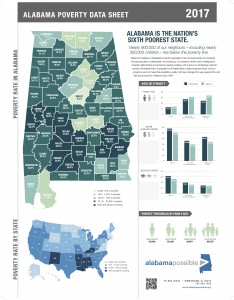 Nearly 900,000 Alabamians live below the poverty line, which is just $24,257 a year for a family of four.
Nearly 900,000 Alabamians live below the poverty line, which is just $24,257 a year for a family of four.
Today, Alabama Possible released its 2017 Alabama Poverty Data Sheet highlights statewide poverty rates and data related to educational attainment, employment, and food security.
Although Alabama’s overall poverty rate slightly declined, and our median household income is up, we still have work to do. The rest of America recovered from the recession at an even faster pace, and the gaps between Alabama and the nation’s poverty rate and median household income are bigger than ever.
Because poverty is so common in Alabama, it can be hard to see. These families are our relatives, our friends, our co-workers, and our neighbors. But they face numerous barriers that result from not having enough money, food, shelter, health care, education, or other necessities of life.
Here’s what the latest data shows:
- Alabama is the sixth poorest state in the U.S., and 18.5 percent of Alabamians live below the federal poverty line – a noticeably larger percentage than the national average of 14.7 percent.
- 14 of Alabama’s 67 counties have a poverty rate higher than 25 percent. Nine counties have a poverty rate higher than 30 percent.
- 26.5 percent – or nearly 300,000 – of Alabama’s children live in poverty.
- Alabama’s median household income is $44,833, which is nearly $11,000 less than the national median of $55,775.
- African American households in Alabama earn far less than white households. According to the data, white Alabamians earn $50,402 whereas African Americans earn $29,180.
- The risk of hunger is closely tied to poverty. Alabama has a notably high food insecurity rate at 17.7 percent, while the U.S. stands at 13.4 percent.
- The child food insecurity rate stands 24.1 percent, which is higher than the national average of 17.9 percent.
Please use the data sheet to guide your policymaking efforts by convening stakeholders, focusing attention on the need, cultivating high aspirations, and supporting work that effectively removes barriers to prosperity in Alabama.
Trackbacks/Pingbacks